The Exam and the Coda
12/16/2008
The final exam given by the Fencing Master’s Program at San Jose State University on December 13, 2008 and it ended a 30 year tradition of fencing education. I was part of that program and took my Master’s examination that day. I had flown in from Spain 6 weeks earlier and trained almost non-stop to prepare. It was the culmination of over 16 years of fencing and 4 and half years of pedagogy training under Maestro Sullins, Maestro Sahm, and Maestra Sahm.
(All photos shown here are courtesy of Steven Flaugher.)
THE ORALS
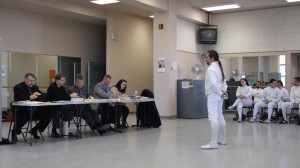
The Oral Examination - (left to right) Maestro Ralph Sahm, Maestro John Sullins, Maestro Sean Hayes, Maestro Paul Scherman, Maestra Janine Sahm, Provost Puck Curtis, Candidate Sydney Thomson, Candidate David Coblentz, Candidate David Cogley, Instructor David Borland, Provost Eric Myers.
Any thought that your own maestri might show favortism in the orals is quickly dismissed as the ones who spend the most time with you grill you mercilessly. These are the maestri that are most invested in your success and the ones who will be most unforgiving of your flaws. The orals covered all three weapons (foil, sabre, epee) in detail.
THE GROUP LESSON
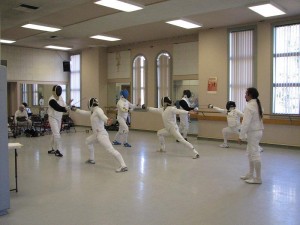
The Group Lesson - Instructing are Provost Eric Myers, Instructor Jeremy Tavan, and Instructor David Borland. Taking are Provost Daniel Williams, Provost Gary Murray, and Instructor Tony Barajas. (In the background is Instructor William Byrne.)
The Group Lesson is intended to judge your ability to control a larger lesson. You divide your eyes between 3 students and are expected to provide feedback to both the students and the instructors. In the action above the attack is directed to the crook of the arm which is a legal target in epee.
TEACHING LESSONS
Here I am teaching before the board to my good friend Eric Myers. For the record, I’m inviting in third which is why my point is high and to my right. The Italian tradition uses the left hand as a visual queue for the lunge. Eric and I informally call it the “traffic cop hand”. The palm says “wait”. When I turn my hand and beckon forward, I’ll bark out the command “Via!” at the same time to draw the lunge from the student. When I want the hit to land, I’ll bark “Hup!”
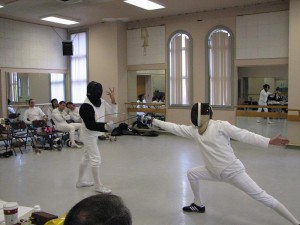
The Amazing Lunge of Provost Eric Myers. (In the background is Instructor Jeremy Tavan, Instructor Kevin Murakoshi, Provost Daniel Williams, and Provost Gary Murray.)
Here I have called out Eric’s lunge to the crook of my arm. When I want him to recover, I will rotate my hand and make a pushing motion. For anyone interested, “Via!” means “Go!” In Italian.
We’ve been training together for almost 5 years to reach this moment. Not all of those times were fun and easy, but the friendship sustained us through the tough times. The looks on our faces says it all. Eric is a gentleman, a scholar, and, of course, a swordsman.
TAKING LESSONS
In addition to teaching, I also had to demonstrate my form taking lessons. Here I am taking a lesson from Provost Myers. For those keeping score, there are 6 elements to the exam: The written, the orals, the group lesson, give lessons, take lessons, and the dreaded random actions. Random actions are actions chosen by the maestri at random that the candidate is required to teach the student. A master’s candidate is expected to be able to do all of these with all 3 weapons and our exam was a bit over 9 hours. In the later photos you can see that the sun has set.
RANDOM ACTIONS
Provost Gary Murray passed his Master’s exam many years ago under Maestro William Gaugler but he has withheld his thesis all this time. Instead, he has dutifully served as the program’s senior Provost for years. His form is almost perfect and his ability to teach is matched only by his personal grace and patience with the people under his care. For each exam, he volunteered to act as the student during the difficult random actions and when he found out the program was closing it’s doors at San Jose and moving to another university, he assured us that he would wait to turn in his thesis until the exam was complete.
For the fencing nerds out there, this action was:
In time, from the student’s invitation in third, grazing beat in 4th with a ballestra and direct cut to the flank. The instructor will parry in second and riposte by glide to the flank. The student will execute a ceding parry of fourth with an expulsion in fourth and riposte by direct cut to the outside cheek.
Maestro Sullins asked me to defeat my student’s expulsion with a disengagement in time, which was a trick question. Fortunately, I told him this was impossible but was able to perform a disengagement in time on the student’s earlier beat. As I said earlier, one’s own maestri will test you the hardest.
THE CODA
After my random actions, Eric was the final candidate left to finish.
Eric’s action was a dizzying series that started with a blade seizure in 3rd and deceive to the crook of the arm followed by a series of additional hits changing distance and targets, followed by a reassemblement to the crook of the arm, a simple parry of second, double circular parry of second, simple third, double circular parry of third, change of engagement to fourth with a riposte by flanconade in fourth which he parried with a ceding parry of fourth to trigger a second intention indirect (in fourth) to the crook of the arm. You see the final attack landing above.
It looks like any other lunge but it’s not. It’s the final action of the day, but it is also the last action in the last exam of the program. In music, the final phrase is called the “Coda” and this was the coda to Maestro Gaugler’s program at San Jose State University. The Maestri applauded and the candidates sighed and Eric and Gary saluted. That was the end of it and this final fencing action was the bittersweet coda.
As the program looks for a new home, I’ll keep the blog updated.
THE GRADUATES AND THE BOARD
Because of the terrible manner in which the program was canceled by the university, the requirement for a thesis was waived. In addition candidates who passed their exam under maestro Gaugler but never turned in a thesis were awarded their certificates which were held in trust pending the completion of a thesis. Earlier in the blog, I referred to candidates by their current title. In the picture below, I have added the new titles.
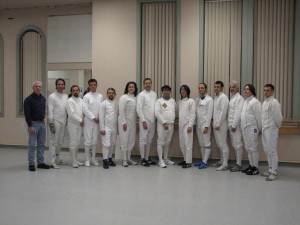
Winter 2008 Diploma Recipients - (left to right) Maestro Greg Hicks, Maestro Gary Murray, Maestro Puck Curtis, Instructor Ricardo Vargas, Instructor David Coblentz, Instructor Sydney Thomson, Maestro Eric Myers, Provost Tony Barajas, Provost Kevin Murakoshi, Provost Jeremy Tavan, Maestro Daniel Williams, Provost William Byrne, Provost David Borland, Instructor David Cogley
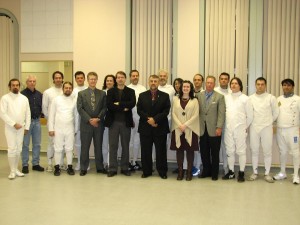
The Candidates and the Board - (left to right) Maestro Puck Curtis, Maestro Greg Hicks, Maestro Gary Murray, Instructor David Coblentz, Instructor Ricardo Vargas, Maestro Sean Hayes, Instructor Sydney Thomson, Maestro John Sullins, Maestro Eric Myers, Maestro Ralph Sahm, Provost William Byrne, Provost Kevin Murakoshi, Maestra Janine Sahm, Provost Jeremy Tavan, Maestro Paul Scherman, Maestro Daniel Williams, Provost David Borland, Instructor David Cogley, Provost Tony Barajas.


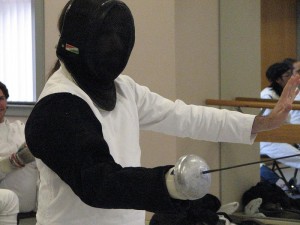
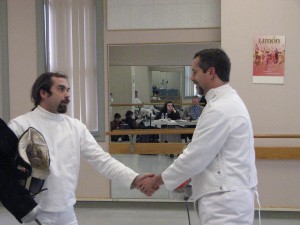
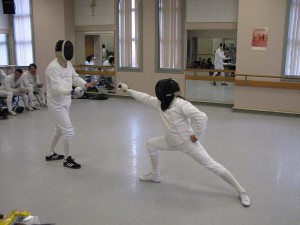
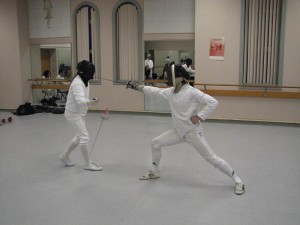
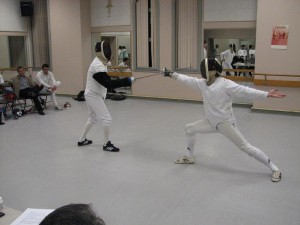
I love the picture of you and Eric shaking hands – your expression is priceless. Hopefully this program will find a home soon – it would be a shame for it not to continue somewhere.
Congratulations again to you, Eric, and all the other graduates.
By Tyson on December 16, 2008 8:34 am
This is such wonderful news. Congratulations!
Thanks for posting pics.
t so bittersweet with the closing of the program. Did the university offer no explanation at all?
By Cindy on December 16, 2008 4:06 pm
They didn’t really provide a reason and they wouldn’t answer letters or take meetings with the maestri. It’s incredibly frustrating because the maestri volunteer their time and the program is almost pure profit for the university. It’s also prestigious in the worldwide fencing community. Maestro Gaugler is an honorary member of the Associazione Italiana Maestri di Scherma (The Association of Italian Masters of Arms), and in 2005 was elected honorary member of the Accademia nazionale di Scherma, Naples (The National Academy of Arms in Naples).
However, San Jose’s loss is another university’s gain and the program won’t even be missing a semester. They don’t have a final home yet, and they won’t be testing maestro candidates, but this semester they have a temporary space and the training will continue.
By Puck on December 16, 2008 6:24 pm
Puck, this is a great post and a wonderful tribute to the program and the people who made it possible. There are few places where I have found such a collection of wonderful people so dedicated to both the preservation and spread of knowledge. I was also particularly lucky to have such a high quality and talented friend to go through this journey with. I look forward to our next adventures
By Eric on December 16, 2008 11:17 pm
My supposition for the reason for the end of the program is this: the California State University system is facing system-wide budget cuts. Each university has to show a certain amount of cuts, so a small program that has no administrative clout is ripe for picking. It doesn’t matter that it’s pure profit to SJSU: the university sends a list of cuts back to the government, and it gets a gold star. From their point of view, a few thousand in tuition is a small price to pay for the gold star.
Now, I don’t *know* that this is the case, but my wife and I are both employed by a state-run university in Oregon, and we see this type of thing happen all the time. But the program will continue, in one form or another: the tradition and knowledge that we represent will not be lost!
By Sean Hayes on December 18, 2008 6:42 am
Nice Pants!!! Very sexy bum!!!
By Robert on December 18, 2008 7:47 am